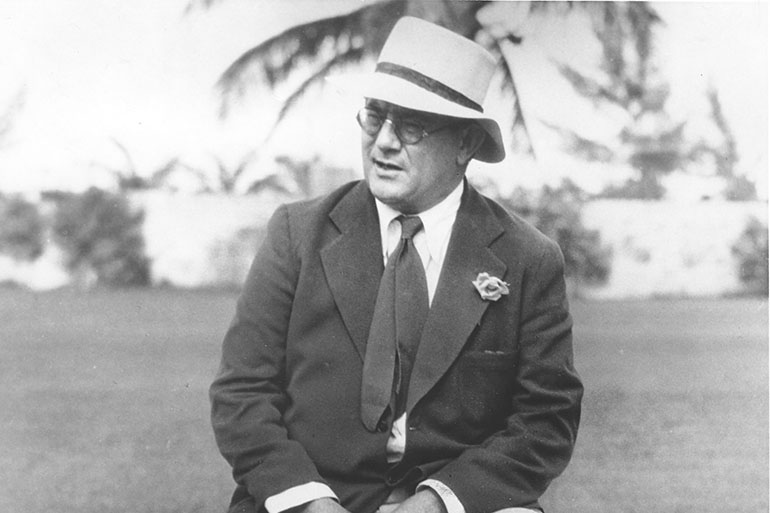Carl Fisher in the 1930s

In 1926, a millionaire named Carl Fisher bought what was then an almost entirely unpopulated Montauk peninsula—all 9,500 acres of it—and built upon it a series of magnificent resort facilities, many of which were a considerable distance from one another. It was a huge project. He built roads so you could drive from one resort to the other, and in one location by the ocean he started what he expected would be a city—it is downtown Montauk today—with a tight grid of roads and sidewalks around a central plaza. To get it started, on one plot he constructed a seven-story office building, expecting that others would build similar ones.
Nobody ever did, though. Fisher opened for business in 1927, a hurricane in 1928 decimated Miami Beach (which he had built earlier), crippling him financially, and then the crash of 1929 finished him off.
Thus, when he went under, he left his resorts—a yacht club, beach club, the Montauk Manor Hotel, the ranch and polo field, fishing village, race track, golf course and glass-enclosed tennis courts—with just a skeleton crew and moved back to Miami Beach to retire in the mansion he had built for himself on a small island he owned in Biscayne Bay, which today is called Fisher Island. He lived there for eight years and died of drink (cirrhosis of the liver) in 1939 at the age of 65.
Fisher heavily promoted all the projects he built in his lifetime. When he was a teenager, he opened a bicycle shop in his hometown of Indianapolis and declared that to demonstrate how well-built his bicycles were, he would push one off a tall building in that city and pedal off with it from wherever it landed, to show it was not broken by the fall. He called all the newspapers and told them of the day and time he would do this. He cleared the area on the sidewalk where it would come down. Some say he had a fresh bicycle standing by near that spot to pedal off. Maybe he did. In any case, he got lots of press and a huge crowd to watch the stunt promoting his shop.
Twenty years later, after breaking the existing speed record for driving a motorcar on a two-mile course, building the Indianapolis Motor Speedway and partnering with the government to develop the Lincoln Highway linking the East and West Coasts, he invited President Horace Harding to play the first round of golf on his new golf course in Miami Beach. The president came first and stood on the first tee, and then Fisher came, his golf bag on his shoulder, riding a full-grown elephant.
“Like Mr. Harding,” Fisher said, “I am a Republican.”
One of the abandoned upper floors of the seven story Carl Fisher office building in Montauk became the first office for Dan’s Papers, 60 years ago. The first floor was occupied by a real estate firm. The second through seventh floors, by that time, had been unoccupied for 30 years, and, because I was a college kid and had no money, the manager on the first floor told me I was free to use any office I wanted upstairs. There was no electricity, no phone line, and the elevator was permanently frozen between the third and fourth floor. What I found upstairs was amazing. It was stuff frozen in time.
Apparently, on a particular day in 1937, everybody working up there just abandoned their desks and left, leaving telephones, chairs, typewriters and desks and filing cabinets open to where they were when they left. A calendar on the wall for 1937 behind one desk was proof. Anyway, because it was a shorter climb, I chose the second floor for Dan’s Papers. And then, in some filing cabinets on that second floor, I found much of the correspondence between Tom Ringwood and Carl Fisher during Fisher’s retirement in the 1930s. Tom Ringwood was Fisher’s manager of what was left of Fisher’s Montauk project in receivership.
There were hundreds of letters. And I read a few dozen of them. It seemed kind of sad. Fisher was asking Ringwood if he could roll up a rug in his Montauk mansion (also abandoned) and send it to him and his wife on Fisher’s Island. Fisher was also asking Ringwood if that big ad in the New York Daily News offering the free first week if you stayed for two weeks worked out. Nobody came from it, Ringwood replied.
I only stayed up on that second floor for one summer, but in subsequent years running Dan’s Papers, research led me to a number of little-known but fantastic promotions that Fisher put together in the 1930s for Montauk, using Ringwood as his agent. This was not a quiet retirement in Miami Beach for Fisher!
For example, in the early 1930s the U.S. Navy had for years conducted its East Coast maneuvers every summer off Newport, Rhode Island. In 1933, Fisher arranged, over the vigorous objections of the Secretary of the Navy, to have those maneuvers off Montauk rather than Newport. Hundreds of Navy ships were offshore Montauk for a week. Fisher expected that many of the tens of thousands of sailors on the ships would come ashore and enjoy his resort. But few did.
Also in 1933, Fisher arranged for the surviving Rough Riders from the Spanish-American War to hold a 35th year reunion at the Montauk Manor. Some of the survivors came—Fisher paid their train passage, room and board—as did all of the New York press. But the rest of the Manor remained almost empty.
A big national sports event in those years was the “Gold Cup.” It was an annual speedboat race around a marked course. I don’t know when they first held it, but it was still going when I was a lad in the 1950s and 1960s, when sometimes more than 100,000 fans came to watch these amazing boats circle a course at more than 100 miles an hour, often in places such as Seattle or Detroit. (The winner of the Gold Cup got to choose the waterway for the next year’s race.)
In any case, the winner of the 1931 Gold Cup was Victor Kliesrath, who was a friend of Carl Fisher’s. He had built a vacation compound in Montauk. (It’s the group of homes with green cobble roofs on Star Island.) As it was Kliesrath’s choice, in 1932 he declared the Gold Cup would take place on a marked course in the way-hell-and-gone waters of Lake Montauk. Much press. Many boats. Lots of noise. Not much in the way of spectators.
Also in the 1930s, a series of motorcar races took place along the winding road of South Fairview Avenue in Montauk. Not much is known about these Le Mans–type races, but a film, much of which was shot from an airplane, shows the cars racing around this course at high speed. I think the Montauk Library has a copy of it in a video format. (I’ve also seen it on YouTube.) Again, not many visitors, but lots of race cars and members of the press.
Today, the seven-story former office building is a sold-out condominium. The Montauk Surf Club and Boardwalk was destroyed in a hurricane, the Montauk Manor is now a hotel and timeshare, the Montauk Yacht Club has become a fabulous resort owned by Gurney’s, the golf course remains and is now a public course, the polo field is intact but now just a livestock pasture, and the glass-enclosed tennis club is a community center. As for the Montauk downtown he built, the circle road around the town green was recently renamed “Carl Fisher Plaza.”



